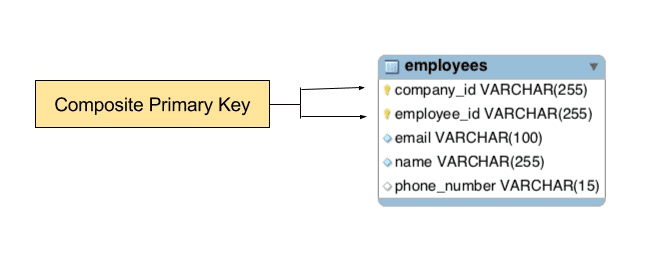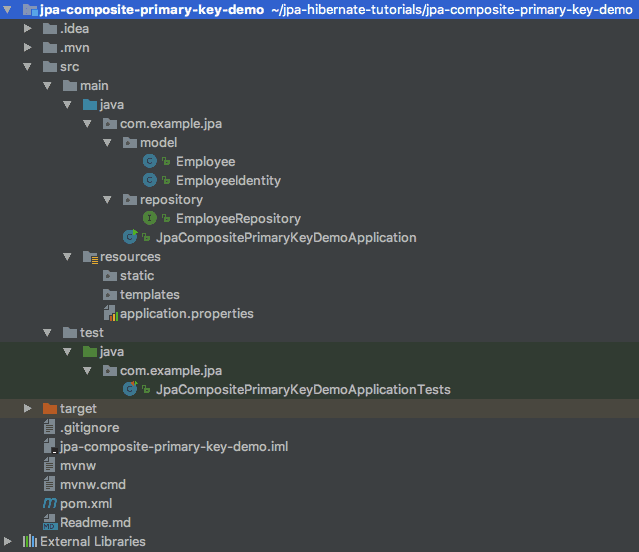JPA / Hibernate Composite Primary Key Example with Spring Boot
Spring BootNovember 26, 20173 mins readIn this article, You’ll learn how to map a composite primary key in Hibernate using JPA’s @Embeddable and @EmbeddedId annotations.
Let’s say that We have an application that manages Employees of various companies. Every employee has a unique employeeId within his company. But the same employeeId can be present in other companies as well, So we can not uniquely identity an employee just by his employeeId.
To identify an employee uniquely, we need to know his employeeId and companyId both. Check out the following Employees table that contains a composite primary key which includes both the employeeId and companyId columns -
Let’s create a project from scratch and learn how to map such composite primary key using JPA and Hibernate.
Creating the Project
You can generate the project quickly using Spring Boot CLI by typing the following command in the terminal -
spring init -n=jpa-composite-primary-key-demo -d=web,jpa,mysql --package-name=com.example.jpa jpa-composite-primary-key-demoAlternatively, You can also use Spring Initializr web app to generate the project. Follow the instructions below to generate the app using Spring Initializr web app -
- Open http://start.spring.io
- Enter Artifact as “jpa-composite-primary-key-demo”
- Click Options dropdown to see all the options related to project metadata.
- Change Package Name to “com.example.jpa”
- Select Web, JPA and Mysql dependencies.
- Click Generate to generate and download the project.
Following is the directory structure of the complete application for your reference -
(Your bootstrapped project won’t have model and repository packages and all the other classes. We’ll create them as we proceed to next sections)
Configuring the Database and Hibernate Log Levels
Let’s add the MySQL database URL, username and password configurations in src/main/resources/application.properties file -
# DATASOURCE (DataSourceAutoConfiguration & DataSourceProperties)
spring.datasource.url=jdbc:mysql://localhost:3306/jpa_composite_pk_demo?useSSL=false&serverTimezone=UTC&useLegacyDatetimeCode=false
spring.datasource.username=root
spring.datasource.password=root
# Hibernate
# The SQL dialect makes Hibernate generate better SQL for the chosen database
spring.jpa.properties.hibernate.dialect = org.hibernate.dialect.MySQL5InnoDBDialect
# Hibernate ddl auto (create, create-drop, validate, update)
spring.jpa.hibernate.ddl-auto = update
logging.level.org.hibernate.SQL=DEBUG
logging.level.org.hibernate.type=TRACEApart from MySQL database configurations, I’ve also specified hibernate log levels and other properties.
The property spring.jpa.hibernate.ddl-auto = update keeps the Entity types in your application and the mapped database tables in sync. Whenever you update a domain entity, the corresponding mapped table in the database will also get updated when you restart the application next time.
This is great for development because you don’t need to manually create or update the tables. They will automatically be created/updated based on the Entity classes in your application.
Before proceeding to the next section, Please make sure that you create a MySQL database named jpa_composite_pk_demo and change spring.datasource.username and spring.datasource.password properties as per your MySQL installation.
Defining the Domain model
A composite primary key is mapped using an Embeddable type in hibernate. We’ll first create an Embeddable type called EmployeeIdentity containing the employeeId and companyId fields, and then create the Employee entity which will embed the EmployeeIdentity type.
Create a new package named model inside com.example.jpa package and then add the following classes inside the model package -
1. EmployeeIdentity - Embeddable Type
package com.example.jpa.model;
import javax.persistence.Embeddable;
import javax.validation.constraints.NotNull;
import javax.validation.constraints.Size;
import java.io.Serializable;
@Embeddable
public class EmployeeIdentity implements Serializable {
@NotNull
@Size(max = 20)
private String employeeId;
@NotNull
@Size(max = 20)
private String companyId;
public EmployeeIdentity() {
}
public EmployeeIdentity(String employeeId, String companyId) {
this.employeeId = employeeId;
this.companyId = companyId;
}
public String getEmployeeId() {
return employeeId;
}
public void setEmployeeId(String employeeId) {
this.employeeId = employeeId;
}
public String getCompanyId() {
return companyId;
}
public void setCompanyId(String companyId) {
this.companyId = companyId;
}
@Override
public boolean equals(Object o) {
if (this == o) return true;
if (o == null || getClass() != o.getClass()) return false;
EmployeeIdentity that = (EmployeeIdentity) o;
if (!employeeId.equals(that.employeeId)) return false;
return companyId.equals(that.companyId);
}
@Override
public int hashCode() {
int result = employeeId.hashCode();
result = 31 * result + companyId.hashCode();
return result;
}
}2. Employee - Domain model
package com.example.jpa.model;
import org.hibernate.annotations.NaturalId;
import javax.persistence.Column;
import javax.persistence.EmbeddedId;
import javax.persistence.Entity;
import javax.persistence.Table;
import javax.validation.constraints.NotNull;
import javax.validation.constraints.Email;
import javax.validation.constraints.Size;
@Entity
@Table(name = "employees")
public class Employee {
@EmbeddedId
private EmployeeIdentity employeeIdentity;
@NotNull
@Size(max = 60)
private String name;
@NaturalId
@NotNull
@Email
@Size(max = 60)
private String email;
@Size(max = 15)
@Column(name = "phone_number", unique = true)
private String phoneNumber;
public Employee() {
}
public Employee(EmployeeIdentity employeeIdentity, String name, String email, String phoneNumber) {
this.employeeIdentity = employeeIdentity;
this.name = name;
this.email = email;
this.phoneNumber = phoneNumber;
}
// Getters and Setters (Omitted for brevity)
}In the Employee class, We use @EmbeddedId annotation to embed the EmployeeIdentity type and mark it as a primary key.
Creating the Repository
Next, Let’s create the repository for accessing the Employee data from the database. First, Create a new package named repository inside com.example.jpa package, then add the following interface inside the repository package -
package com.example.jpa.repository;
import com.example.jpa.model.Employee;
import com.example.jpa.model.EmployeeIdentity;
import org.springframework.data.jpa.repository.JpaRepository;
import org.springframework.stereotype.Repository;
@Repository
public interface EmployeeRepository extends JpaRepository<Employee, EmployeeIdentity> {
}Code to test the Composite Primary Key Mapping
Finally, Let’s write some code to test the composite primary key mapping. Open the main class JpaCompositePrimaryKeyDemoApplication.java and replace it with the following code -
package com.example.jpa;
import com.example.jpa.model.Employee;
import com.example.jpa.model.EmployeeIdentity;
import com.example.jpa.repository.EmployeeRepository;
import org.springframework.beans.factory.annotation.Autowired;
import org.springframework.boot.CommandLineRunner;
import org.springframework.boot.SpringApplication;
import org.springframework.boot.autoconfigure.SpringBootApplication;
@SpringBootApplication
public class JpaCompositePrimaryKeyDemoApplication implements CommandLineRunner {
@Autowired
private EmployeeRepository employeeRepository;
public static void main(String[] args) {
SpringApplication.run(JpaCompositePrimaryKeyDemoApplication.class, args);
}
@Override
public void run(String... args) throws Exception {
// Cleanup employees table
employeeRepository.deleteAllInBatch();
// Insert a new Employee in the database
Employee employee = new Employee(new EmployeeIdentity("E-123", "D-457"),
"Rajeev Kumar Singh",
"rajeev@callicoder.com",
"+91-9999999999");
employeeRepository.save(employee);
}
}We first clean up the Employee table and then insert a new Employee record with an employeeId and a companyId to test the setup.
You can run the application by typing mvn spring-boot:run from the root directory of the project. The Employee record will be inserted in the database once the application is successfully started.
Querying using the Composite Primary Key
Let’s now see some query examples using the composite primary key -
1. Retrieving an Employee using the composite primary key - (employeeId and companyId)
// Retrieving an Employee Record with the composite primary key
employeeRepository.findById(new EmployeeIdentity("E-123", "D-457"));2. Retrieving all employees of a particular company
Let’s say that you want to retrieve all the employees of a company by companyId. For doing this, just add the following method in the EmployeeRepository interface.
@Repository
public interface EmployeeRepository extends JpaRepository<Employee, EmployeeIdentity> {
/*
Spring Data JPA will automatically parse this method name
and create a query from it
*/
List<Employee> findByEmployeeIdentityCompanyId(String companyId);
}That’s all! You don’t need to implement anything. Spring Data JPA will dynamically generate a query using the method name. You can use the above method in the main class to retrieve all the employees of a company like this -
// Retrieving all the employees of a particular company
employeeRepository.findByEmployeeIdentityCompanyId("D-457");Conclusion
Congratulations guys! In this article, you learned how to implement a composite primary key in hibernate using @Embeddable and @EmbeddedId annotations.
You can find the entire source code for the sample project that we built in this article in my jpa-hibernate-tutorials github repository.
Thanks for reading. See you in the next post.


